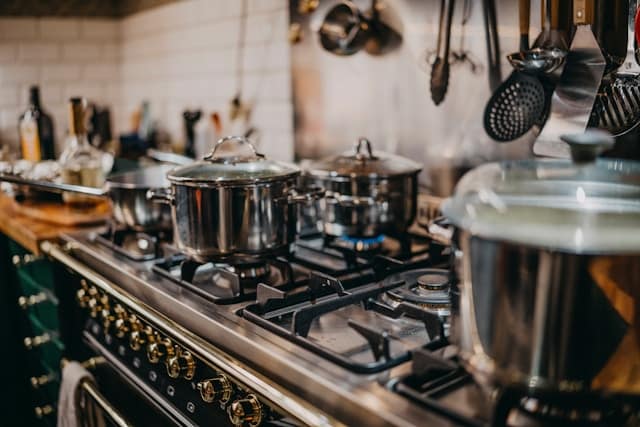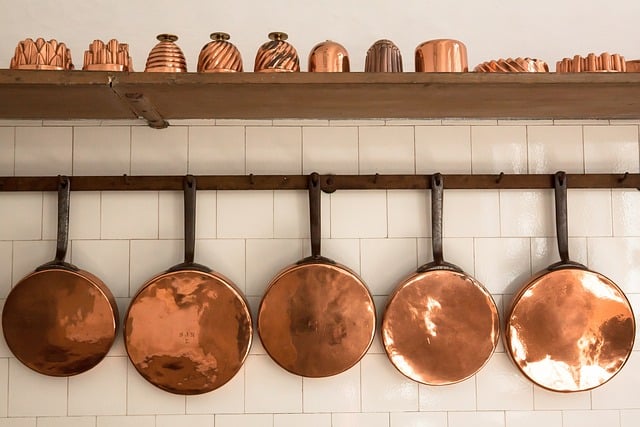Toxin-Free Cooking with the Right Pots and Pans
You worry about what foods you’re eating, you research, you read labels, you stay up-to-date on nutrition blogs. But you may be missing an important factor in your health journey if you’re not paying attention to the best non-toxic cookware options and what your cookware is made from.
There are so many pots and pans being sold in stores and online, some with hefty price tags. But knowing which ones are fads and which ones are tried and true can help you avoid exposure to damaging toxins. The good news is that the best non-toxic cookware options are not always the priciest.
Before you cook up an egg, sauté some veggies or start a big batch of soup, check out the best types of cookware for your kitchen and get ready for toxin-free meals.
There are a number of materials that cookware is made from these days and labels can often be deceiving. Pots and pans may be made from a single material or have a base material with a coating, like an iron pan with enamel.
Ability to heat up quickly, response to temperature change and heat distribution may all differ depending on the type of cookware used. If you have an induction stove, you may need to take that into consideration as well since only cookware made with magnetic metals will work on induction stovetops.
The last factor is mineral overload. Some metals can leach minerals into your food, which may not actually be a bad thing if you are deficient. But over time, using the same kinds of pots and pans can expose you to too much.
Non-stick Cookware
“Non-stick” has become a general term for a range of cookware that has a coating that prevents foods from sticking to the pan. What makes up this coating varies greatly.
Since the 1960s, Teflon has been used for non-stick coating but has fallen out of favor because of its known increased risk of cancer. Teflon is a chemical called C8, which is a perfluorooctanoic acid (PFOA), a part of the per- and poly-fluoroalkyl substances (PFASs) family. Teflon made from C8 has now been banned since 2014 but versions of Teflon are still being sold.
Now, similar products are available that proudly proclaim to be Teflon-free but are not any better.
PFAS are still used in some of these coatings, so while from a marketing standpoint, these products can claim to be PFOA- or Teflon-free, they may not be free of all PFAS.
Exposure to PFAS, sometimes called “forever chemicals” due to the difficulty of eliminating them, have been found to suppress the immune system, cause birth defects and increase cancer risk.
While the ease of non-stick pans can be tempting, they are not recommended, as there are healthier options that may not cause sticking… or cancer.
Ceramic Coated
Ceramic-coated cookware has become the non-stick option for people avoiding non-stick. In other words, it may not contain PFAS but may still be just as problematic as traditional non-stick pots and pans.
This type of cookware can range in the base material but can have a coating of silicon dioxide made from sand that creates a surface that prevents sticking.
This coating has been found to risk leaching titanium and silicon into foods with regular use and care. Also, if the coating is scratched, foods are exposed to the base metal, which is often aluminum because it’s good for heat distribution.
If you really need cookware that will instantly be non-stick, ceramic is a better option than Teflon-like products, but keep in mind they do not stand up to high heat and the non-stick properties may not withstand the life of the pan. Also consider that some ceramic cookware works with induction stoves and others don’t so check labels.
Stainless Steel

Uncoated stainless steel cookware is a great all-purpose option because it can go from the stovetop to the oven and even stand up to broiling (depending on the handle). It is durable and works with induction stoves. Sticking can occur and cleaning can be difficult. But they do not require any special care and soap and water is usually plenty. It can take some getting used to cooking with stainless steel because it’s best to allow them to heat up fully before adding food. And sufficient oil may be needed.
Some stainless steel options may still have a coating if it claims to be non-stick so checking labels is crucial. As long as there is no coating, stainless steel should not cause leaching or react with foods. The exception is very acidic foods, which may leach a very trace amount of chromium and nickel over extended cooking.
Overall, stainless steel is great for cookware and is one of the easiest and safest options. All you need is to make sure you’re getting real, uncoated stainless steel and maybe a little practice cooking with it.
Glass
Cookware made from uncoated glass may be one of the cleanest you can find but it can also be tricky.
While glass will not leach any toxins into your foods, older glassware was often tempered with other materials. New products available for purchase now have stricter regulations than those you might be able to pick up in second-hand stores or from your grandma’s house.
This can be true of the coatings found on some glassware too. But it doesn’t get much cleaner than glass for your cookware.
The trickiness comes from how sensitive glass can be. Glass is obviously fragile when it comes to storage and maintenance but the actual cooking may be a problem too since glass can crack or shatter from too high heat or change in temperature.
Glass can take a while to heat up but once it does, it maintains temperature well. It will not work with induction stoves.
Cast Iron
There is a reason professional chefs love cast irons. And a reason well-seasoned cast iron pans have been known to be passed down for generations.
Cast iron pots and pans conduct heat well, are sturdy and take a beating, and can withstand high heat. They can also offer a great sear and go from stovetop to oven easily.
Probably the two biggest complaints about cast iron are the weight and confusion over care. People are often nervous about the pans losing their seasoning and rusting.
To avoid rusting, keep the surface well oiled. But yes, you can use metal scrubbers and even soap, as long as it is re-seasoned with oil. There is also the salt method.
Although there is some concern over iron exposure in extended cast iron use, rotating between cookware materials should keep levels safe. In fact, many iron-deficient individuals use these pans to help balance their iron levels.
This should remain true even with higher-acidity foods if the pan is well seasoned, just not for extended cooking.
Cast iron cookware tends to be a good option that won’t cost an arm and a leg but will last nearly forever. Plus it works great with induction stoves.
Copper

Probably one of the most beautiful types of cookware, copper definitely has its pros and cons.
Copper is incredibly responsive to heat but usually cannot be used on induction stoves. Some pots and pans use only copper while others combine it with stainless steel to add to that metal’s responsiveness. It may also be lined with tin.
Copper works best for baking and making homemade chocolate, candy and custard.
But in addition to what is usually a steep price, there are some other issues with copper.
Caring for copper can be complicated because it dents and tarnishes easily.
There is also some concern of copper toxicity but this is mostly an issue with acidic foods, which are not recommended in copper cookware. Because of this, these days most copper pots and pans are coated. Unfortunately, the coating is usually nickel or tin, which wear away quickly and can also have their own toxicity issues.
While it may be tempting to just leave the beautiful pots hanging as decoration, using copper wisely and in rotation with other materials allows you to put that beauty to good use.
How to Choose the Best Non-Toxic Cookware for Your Kitchen
Finding the best non-toxic cookware options can seem tricky but as with food, sometimes variety is the best approach.
Take into account what you are cooking, at what temperature and for how long. And if you want to keep an array of options on hand, the best assortment would include cast iron and stainless steel, with glass and copper playing an occasional role.
The best ones will last a long time if you give them the care they need, giving you years of seared meats, sautéed greens, hearty soups, comforting breakfasts and special desserts.
Ready to take your health and nutrition knowledge to the next level?
Join our Nutrition Therapist Master Certification program and become an expert in holistic wellness, including how everyday choices—like cooking with non-toxic cookware options—impact health. Apply today and empower yourself to make informed decisions for a healthier lifestyle! Learn More
About the author: Maya Strausberg earned her Master Nutrition Therapist certification from NTI before starting her nutrition therapy private practice. She now offers writing and editing services for nutritionists and other health practitioners around the world through her business, Family Tree Nutrition.
Photos:
- Photo by Cathal Mac an Bheatha on Unsplash
- Photo by Janko Ferlič on Unsplash
- Image by stux from Pixabay
The post Toxin-Free Cooking with the Right Pots and Pans appeared first on NTI School.